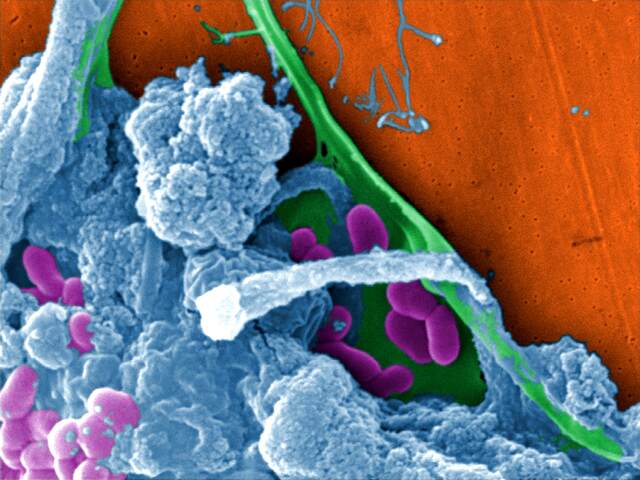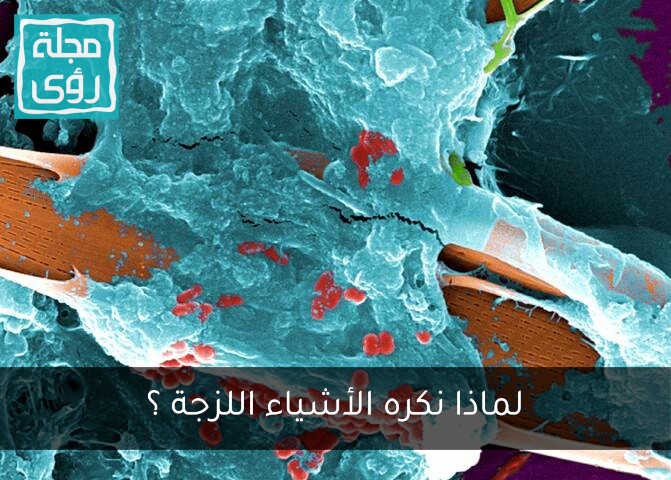
We have an innate sense of disgust at sticky things and a tendency to stay away from them, but what is the secret of this feeling and does it have justification?
In nature, stickiness is usually caused by sugars or proteins. Of course, the presence of these sticky substances on your skin or hair would attract insects and help to accumulate dirt and all things that can cause illness.
Sticky objects also prevent our skin from working as intended, affecting heat exchange and so on. So this makes humans and even animals feel bad when covered by something sticky.
In contrast, toddlers have an innate love of new experiences and sensations in general, and sticky things look different from usual so the little ones are attracted to play with slime, dough and other sticky things.
All of the above is normal and self-evident but what you don’t know is that sometimes-sticky objects can be a repository of the most dangerous species of living things on earth.
Biofilm colonies
Microorganisms such as bacteria and fungi – just like animals and humans – tend to live in groups where this gives them an additional ability to resist environmental conditions, so some types of bacteria and fungi resort to forming a viscous gelatinous membrane of sugars and proteins and water surrounding them called the biofilm.
This film contributes to its protection from dehydration, antibiotics, antiseptics and immune systems in organisms that may infiltrate it.
This process is often carried out in humid environments such as the edges of rivers and swamps and perhaps the most prominent example nearby is the courses of birds, animals and ponds that are not constantly cleaned as organisms such as bacteria stick to solid objects and then begin to form a biofilm that will later turn them into a colony of Super bacteria.
The bad news here is that your infection with this type of bacteria far exceeds the infection of ordinary types of them and to understand how dangerous these bacteria are swimming in the gel here are some of their amazing properties: –
- The resistance of these bacteria to antibiotics is 10,000 times that of individual bacteria!
- The gel surrounding bacteria is an obstacle to antibiotics and immune cells reaching them Like a small intelligence service, bacteria exchange information among themselves that helps them resist antibiotics.
- In the outer layer of this membrane, the immune system is fooled by the dead bacteria on the surface, the bacteria inside the gel are active and able to multiply again and again to get infected again.
- Biofilm bacteria cause nearly 80% of infectious diseases in humans Some of the health problems caused by this bacterial gel: –
These biofilms are not far from you as you might think, some of them live on the teeth of most humans, which is what forms that oily layer that surrounds the teeth and can cause problems like tooth decay and inflammation of the oral mucous membranes, There is Bone infections due to contamination of wounds with these bacteria.
Infection with these bacteria may also be linked to the use of contaminated medical devices or tools such as :-
- Endocarditis if contaminated heart valves are installed
- Keratitis resulting from wearing contaminated contact lenses as well as an infection of the eye fluid in which a transplant has been performed such as a contaminated corneal transplant and this injury may lead to total vision loss.
- Chronic urinary tract infection due to the use of contaminated urine catheters.
The impact of these bacteria is not limited to medicine only, but may cause many problems such as damage to food and pharmaceutical products, obstruction of the work of devices and equipment, and corrosion and damage to concrete.
Conclusion
If you hate sticky things, maybe your intuition is right, sticky things are home to antibiotic-resistant biofilm bacteria, one of the most dangerous organisms to human health.
اكتشاف المزيد من مجلة رؤى
اشترك للحصول على أحدث التدوينات المرسلة إلى بريدك الإلكتروني.


 الاستهداف الجغرافي: أظهر المحتوى المناسب حسب موقع الزائر لضمان تقديم العروض الإقليمية بدقة.
الاستهداف الجغرافي: أظهر المحتوى المناسب حسب موقع الزائر لضمان تقديم العروض الإقليمية بدقة. الجدولة الزمنية: تحكم في توقيت ظهور المحتوى مع ميزة تحديد تاريخ بدء وانتهاء الإعلانات.
الجدولة الزمنية: تحكم في توقيت ظهور المحتوى مع ميزة تحديد تاريخ بدء وانتهاء الإعلانات. استهداف اللغة: تحدث بلغة زوارك لتوفير تجربة سلسة وشخصية.
استهداف اللغة: تحدث بلغة زوارك لتوفير تجربة سلسة وشخصية. استهداف الجهاز: عرض محتوى يتناسب مع الأجهزة المختلفة سواءً كانت هاتفاً محمولاً أو جهازاً لوحياً أو كمبيوتر مكتبياً.
استهداف الجهاز: عرض محتوى يتناسب مع الأجهزة المختلفة سواءً كانت هاتفاً محمولاً أو جهازاً لوحياً أو كمبيوتر مكتبياً. استهداف النظام والمتصفح: لضمان التوافق مع أنظمة التشغيل والمتصفحات المختلفة.
استهداف النظام والمتصفح: لضمان التوافق مع أنظمة التشغيل والمتصفحات المختلفة. استهداف أدوار المستخدمين: قدم محتوى حصرياً للأعضاء أو المشتركين أو حتى المشرفين.
استهداف أدوار المستخدمين: قدم محتوى حصرياً للأعضاء أو المشتركين أو حتى المشرفين. سهولة الاستخدام: قم بإضافة الاختصارات بسهولة لأي جزء من موقعك.
سهولة الاستخدام: قم بإضافة الاختصارات بسهولة لأي جزء من موقعك. اجعل موقعك أكثر ذكاءً واحترافية، وابدأ باستهداف زوارك بدقة لتحقق أقصى استفادة من موقعك.
اجعل موقعك أكثر ذكاءً واحترافية، وابدأ باستهداف زوارك بدقة لتحقق أقصى استفادة من موقعك.
Leave a Reply